Elderflower Champagne
A beautifully light, sparkling summer drink that’s easy to make and requires no specialist equipment. This recipe makes 5 litres – but if you have a large enough bucket, you can make a larger batch simply by multiplying the quantities.
The fizz in elderflower champagne is generated by active yeasts that will continue to work in the bottle for up to four months. If you don’t drink your champagne as soon as it’s ready, bear in mind that it will keep getting fizzier and you’ll need to ‘burp’ the bottles as time goes on (just open the caps every now and then to release any gas that has built up). In the unlikely event that you find yourself with a half-drunk bottle that’s gone flat, just put it back in the fridge for a couple of days to restore its sparkle.
Though plastic bottles are something that we all ought to be avoiding as a rule, we use them here for safety reasons. If you want to use glass, you’ll need to get hold of champagne bottles which have heavyweight glass specially designed to withstand the pressure of the gas that builds up during fermentation, and use special corks and wire cages. Plastic is a safer, more accessible option. Our trick is to buy a batch of supermarket table water, using the water to make the champagne and decanting our brew into the empty plastic bottles.
- 6 large elderflower heads
- 500g granulated sugar (this quantity gives a fairly dry champagne – use more sugar if you’d prefer a sweeter drink)
- 2 medium lemons
- 1 tablespoon white wine vinegar
EQUIPMENT NEEDED
- Sterilising powder (you can usually find the Milton brand in chemists and supermarkets)
- A non-reactive (plastic, enamel or stainless steel) bucket, to hold 5 litres of water
- Grater or potato peeler, for zesting the lemons
- Lemon squeezer
- Long-handled spoon
- Sieve
- Muslin
- Funnel
- Large jug
- Slotted spoon
- 5 empty 1-litre plastic bottles (or equivalent volume)
Method
- Sterilise the bucket, spoon, lemon squeezer and grater (or potato peeler) using the sterilising powder by following the instructions on the pack.(The scent of chemicals will disappear once everything has dried).
- Put 5 litres of water into the bucket. Add the sugar and stir vigorously to dissolve (you may need to warm the water a little if the weather is cold – if so, allow the water to cool again before proceeding). Pare or grate the zest from the lemons and squeeze the juice. Add the zest, juice and remains of the lemons to the bucket. Stir in the wine vinegar.
- Pick or snip the flowers from the stalks, handling them as gently as possible to avoid shaking off the aromatic pollen. Add the flowers to the bucket and discard the stalks. Stir the water gently and cover the top of the bucket with a clean tea towel or a large plate – anything that is not airtight will do.
- For the next 3–5 days, stir the contents of the bucket daily, making sure that any sediment of sugar gets dissolved. Quite soon the flowers will become waterlogged and sink, but as the yeast in the mixture becomes active, it will produce gas and the flowers will rise to the surface again. If you listen closely you may hear the sound of fizzing. You may also see a little mould growing on the top, usually starting around the floating lemon shells. Don’t worry, this is quite normal. Along with the floating flowers and the fizzing sound, this is a signal that it’s time to bottle your champagne.
- In preparation for bottling, sterilise the large jug, sieve, funnel, slotted spoon and your plastic bottles. Skim off everything that is floating in the bucket, using the slotted spoon.
- Strain batches of the liquid through the sieve lined with muslin into the jug, then pour the strained liquor through a muslin-lined funnel into the plastic bottles. Leave about 5cm of space at the top of the bottle, and make a small dent in the shoulder of the bottle with your thumb before tightly screwing on the cap. As the champagne starts to get fizzy, the depression will pop out to let you know that the champagne is working. The pop should happen around 3 days after bottling, but might happen sooner if the weather is warm.
- Leave the bottles in a cool dark place, checking them regularly to see if they need ‘burping.’ The champagne should be ready to drink in roughly 2 weeks – you’ll know because the bottles will feel really solid from the build-up of fizz inside. Remember to ‘burp’ the bottles if you keep the champagne for longer – just open the caps every now and then to release some gas.
Notes
This drink contains live yeast and will continue to ferment in the bottle so it is best to use it up before October/November.
You can use 10g dried elderflowers instead of fresh ones, but you’ll also need to add ¼ teaspoon wine yeast.
Credits
Recipe by Wild Food UK, photos by Otherwise for Wild Food UK

COMMENTS




 (246 votes, average: 3.49 out of 5)
(246 votes, average: 3.49 out of 5)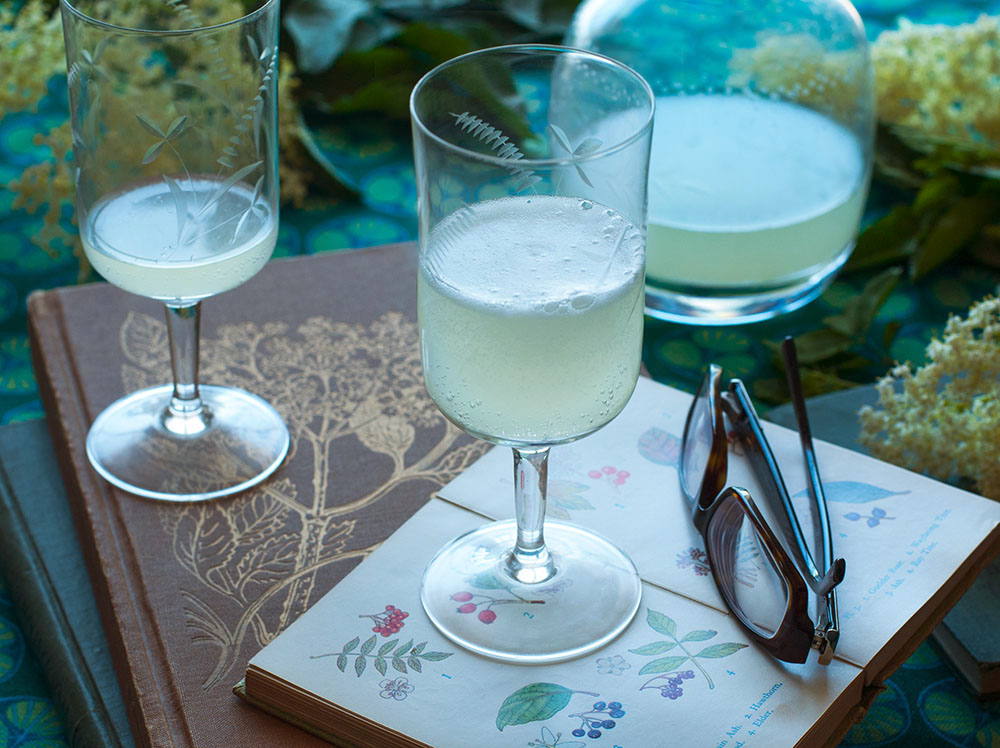
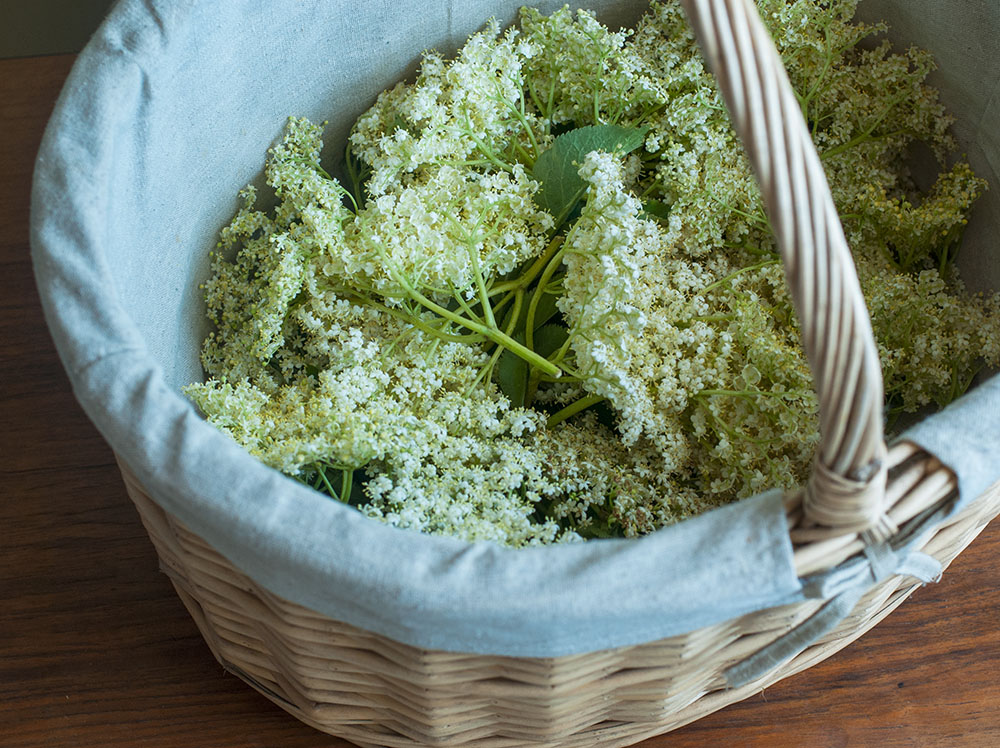
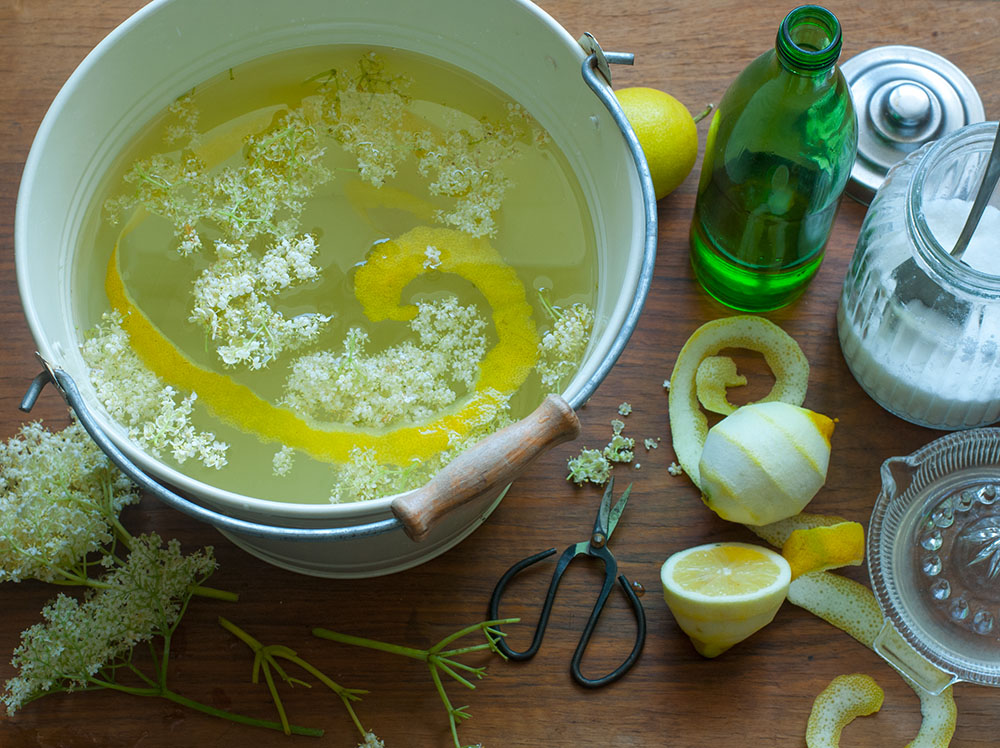
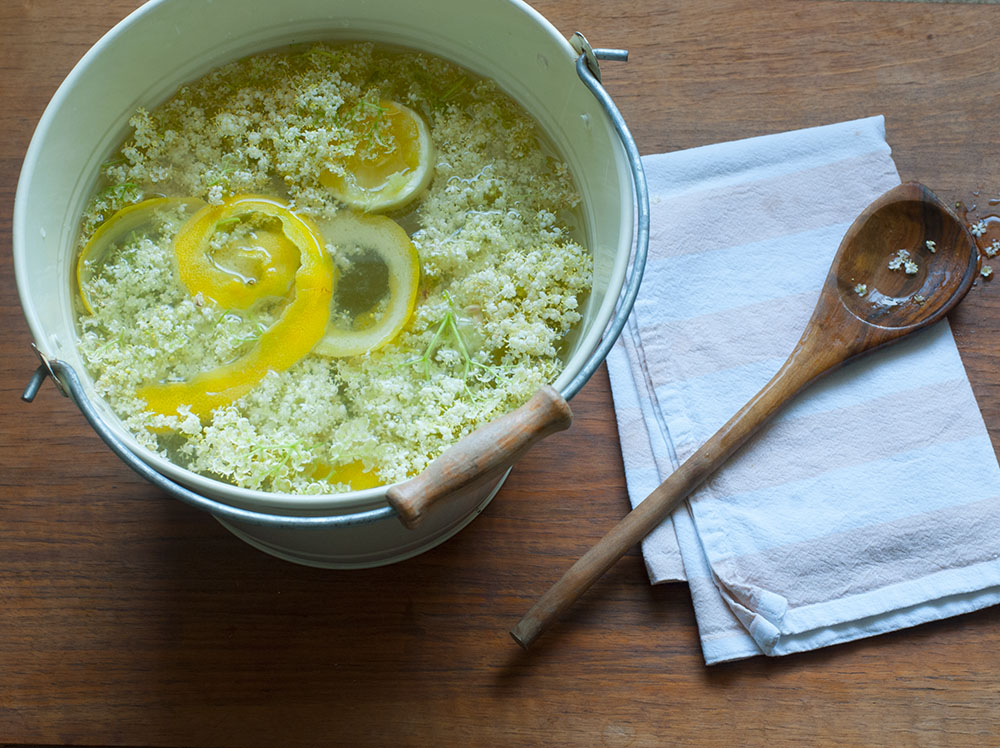
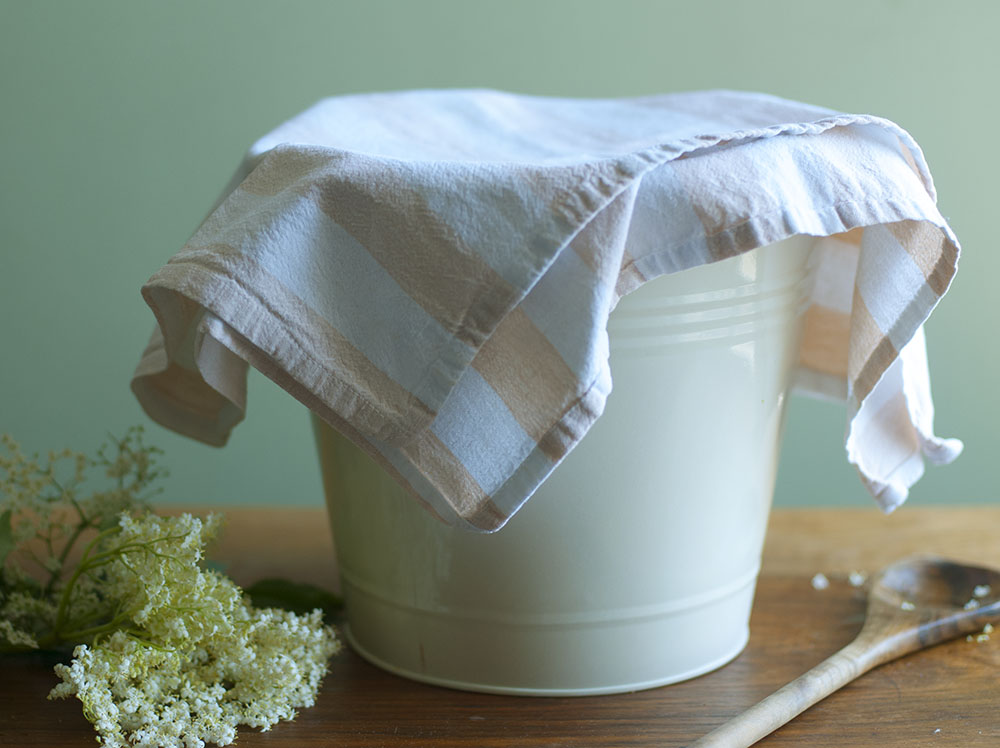
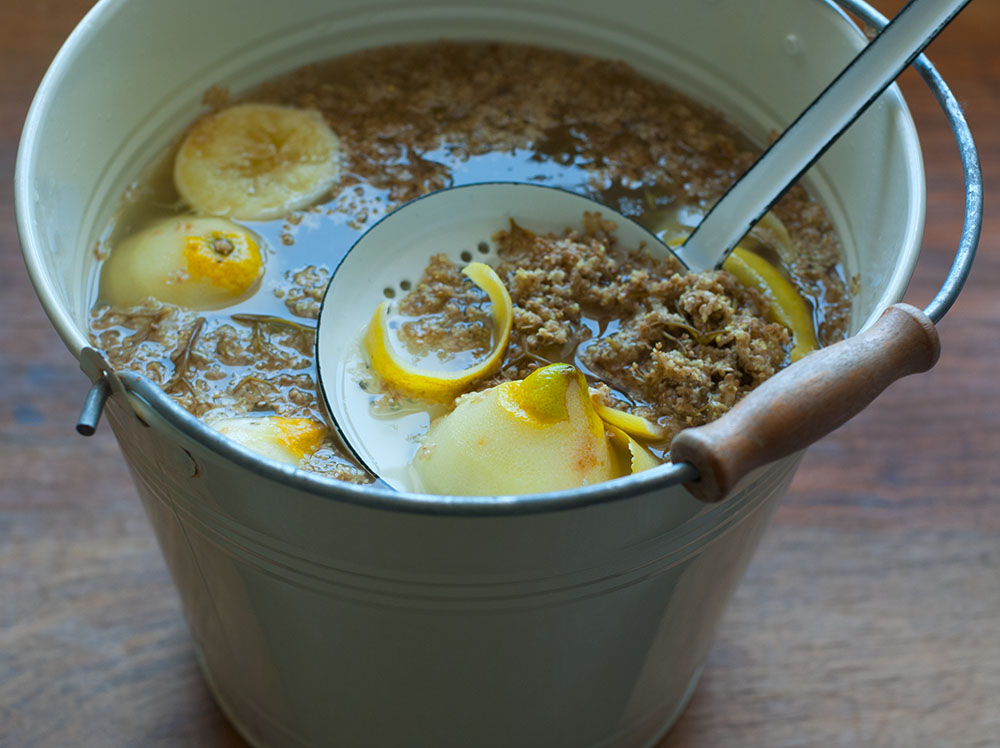
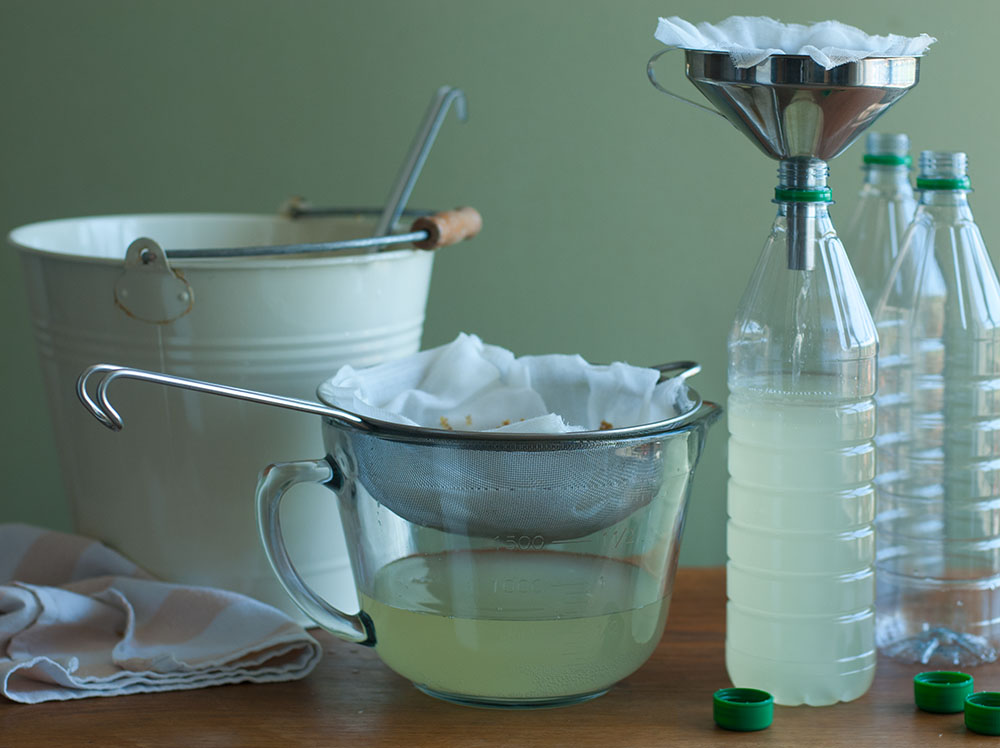
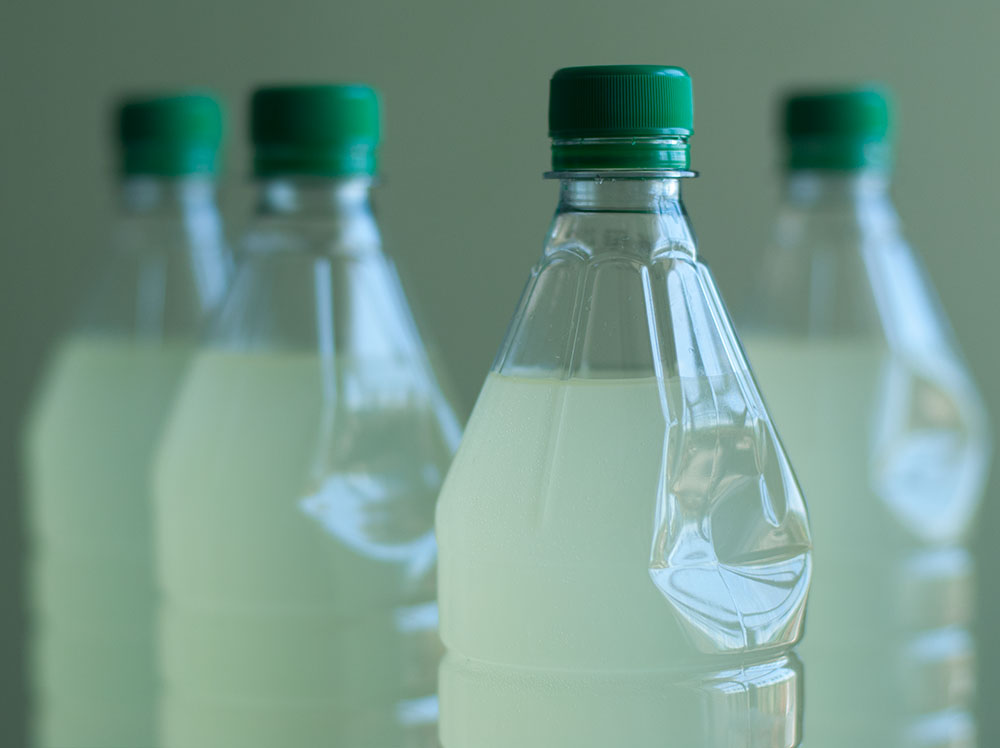
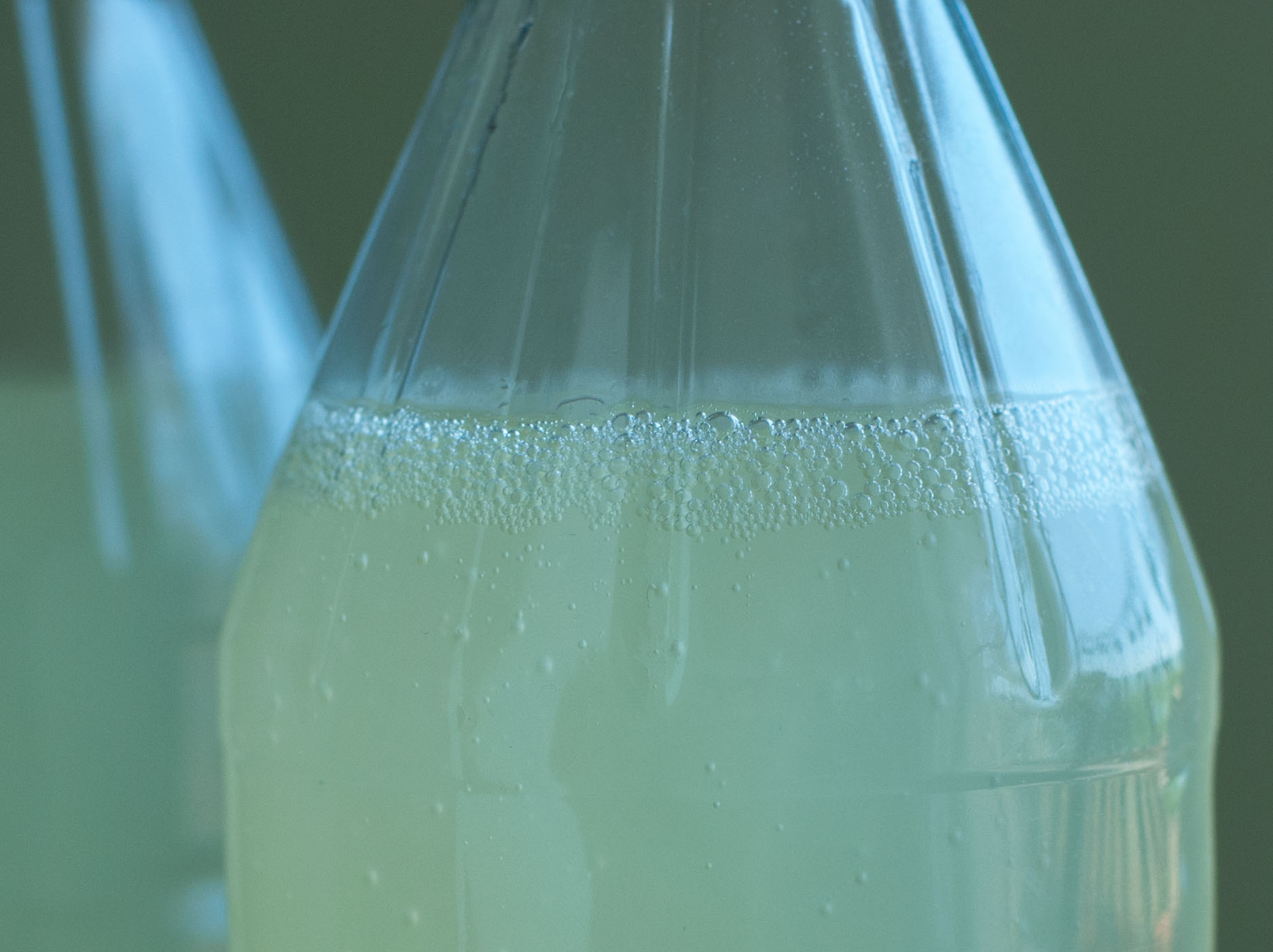
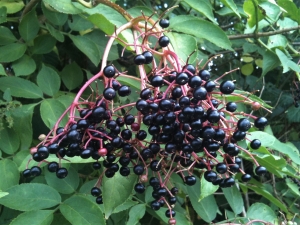
Made 20L last summer, froze 10L and defrosted it in the Spring, still tasted good still fizzy, keeps much longer than 4 months.
Great recipe
Thanks
Did you freeze it in the bottles before fermenting? Or after?
Hi, Your recipe says 3 lemons for 10 litres and your video says 10 lemons for 20 litres…. Can you advise?
I made this last year, following your video and it was great, but can’t remember if I followed the receipe or the video quantities..
Hi Jenny, we normally use large lemons, hence 3 for 10 litres. In the video, Marlow had small lemons, hence 10 for 20 litres, sorry about the confusion.
Will certainly try this out. It looks amazing. Can I ask if we can use stainless steel containers for the brewing instead of plastic buckets?
Thank you
I never have, but I don’t see why not. 🙂
Hi Anna, I’ve never tried with Stainless I’m afraid but I can’t see that it would affect the taste.
Milton can damage stainless steel. You’d want to use a different sterilisation method if you’re using metal buckets
Can I use dried elderflower and if so what weight instead of fresh
Yes, you can use 20g dried elderflowers instead of fresh ones. You will also need to add 1/4tsp of wine yeast though.
I have elderflower cordial around still.
That is made with 2 of everything. 2 dozen heads, 2 lb of sugar, 2 lemons, 2 pints of water… ish, very “ish”
so i will line a large aluminium stock pan with a bin bag to stop the metallic taste, add 10 litres of water to “ a bit” of the cordial. (Probably a mug or 1/2 pint), throw in a chopped up lemon, a bag of sugar and …
I have some cider vinegar with the mother? Or just bakers yeast? Or some grapes?
Any advice welcome…
Many thx.
Hi Stephanie, We don’t use any yeast unless we are in a rush to make the champagne, half a teaspoon of brewers yeast per 20 litres will usually have the champagne ready in just over a week. Left without the addition of yeast it takes about three weeks.
Hi Eric,
Thank you for a lovely instructive day in Linton Ross on Wye. We just got it in in time I think!
Can glass bottles be used for the Champagne?
Hi Wayne, you can use proper champagne bottles with the correct corks otherwise I would use plastic in case of explosions.
Can I use cider vinegar instead of wine vinegar and brewing sugar instead of normal household sugar?
It should work and it’s good to experiment, it doesn’t always work but new things are discovered by experimenting.
Hi, we’ve just bottled our first 20l batch today. What’s best for storing the bottles for the next couple of weeks – somewhere cool & dark or just on the windowsill?
Cool and dark is best, warm and dark will work quicker.
Hi there, I just made some elderflower cordial for the first time but it’s horribly sweet and so I’m wondering about leaving it to ferment a bit so it’s less sweet and more boozy. What do you think? Would that work out? I also am making some kombucha so another option could be to save it to splash into my second booch ferment. What do you think? I don’t want to waste what I’ve done so your thoughts would be appreciated. Thank you!
Sorry for the late reply, I wouldn’t know about the Kombucha but you could water the mix down and rebottle it, it never seems to take long to re-fizz, allowing it to ferment more could help but I have had some turn to a not very pleasant vinegar.
Hey, this is a great recipe and works really well.
Do we need to keep these bottles in the fridge once bottled or wait until they have been opened again?
It’s best to keep them dark and cool until you want to drink some, then refridgerate.
Hello – I made my 20L batch on June 1, bottled it June 5 (there was mould as indicated). Absolutely no fizz so far (as of June 10). Should I wait, or put it back into the fermentation bin and add yeast?
Be patient, it can take longer sometimes. I add a tiny pinch of yeast to bottles that don’t react after three weeks and that usually does the trick.
Hi. I know this was posted some time ago but I hope you will reply. I made my first batch a couple of weeks ago now.. it smells lovely, it is slightly effervescing but my starting SG was 1.04 (it did nothing so I added a packet of champagne yeast) the SG went up as obv the density had increased but has started to fall… it’s falling 0.02 a day and we’re on 1.038 today. It’s been a freezing June. I’m happy to be patient but I really thought I’d have bottled by now. Should I persist or add some extra sugar/yeast to speed the job up? Thanks in advance.
Hi Jayne, I’m afraid I don’t check the gravity when making the champagne. Everyone does it slightly differently but I let the ingredients steep for only three days then strain and bottle. I’ve never used champagne yeast as I treat the champagne as an almost soft drink, the way I make it, it will be less than 1% in strength.
Thanks. Sorry I didn’t realise I’d attached to another thread. My technical skills are about up to my champagne making skills. Just to say, all is well. The last few days of warm weather have seen the specific gravity fall to 1.00 (which seems to be the magic number on other sites). So I’ve bottled. I’ve made 6 champagne bottles (which I bought from the internet) and one plastic drinks bottle – as my tester. Thank you also for your lovely piece on how to make Elderflower champagne. I hadn’t intended to make an alcoholic drink per sa but interestingly (new to me) a hydrometer also predicts the final absolute proof based on the starting SG. Mine comes out at 7% so probably not for our children. Cant wait to try, it’s tasting nice. My elderly Father is aghast this worked with simply a bucket from B&Q and a teatowel. For interest if anyone struggles with low pollen flowers (as this year was wet and cold) it really has worked adding one sachet of champagne yeast and a bit more sugar. Patience prevailed. Best wishes.
Tried your recipe. There was only one problem. The natural yeast didn’t work so I had to use some universal wine yeast because nothing was happening after 7 days. With the wine yeast the fermentation was complete in 4 days (starting gravity 1.032, final gravity 0.998). It is bottle now so I will patiently wait 2 weeks to know the final result. A quick taste when bottling confirmed that all was OK, despite no yeast protection for the first week.
I have got some sediment in my fizz which is now on its second week of brewing in old lemonade plastic bottles. Every time I burp the bottles a little rises to the top. Also the fizz is still looking like cloudy lemonade too. Will it go clear, and what to I do about the sediment.
Sometimes there is more sediment than others and although it doesn’t look very appetising it is not harmful in any way. I only burp bottles if they are looking explosive and I want them to last a bit longer otherwise they are ready and can be consumed.
Hi there,
I diligently followed your recipe, and bottled ten litres of Elderflower Champagne on the 3rd of June. They wouldn’t wait two weeks and I’m currently finding that I have to ‘burp’ the bottles twice or three times every day, as the bottles become round bottomed! Is this a good thing or am I doing something wrong?
All the best,
Trish
There are always different amounts and different strains of natural yeast on the flowers, it sounds like you have a lot of yeast in your batch. If you are burping the bottles it is ready for drinking.
Thank you for your reply Eric, and for the reassurance to get drinking! 😁👍🏼
Hi
Does the end product have much (if any) alcohol content?? Asking for a friend!
There may be 1% if you are lucky, you can add champagne yeast to bring the strength up but it also becomes more explosive. I find it makes a great vodka or gin mixer if you prefer a stronger drink.
Can you use the flowers from the purple leaved garden variety?
It is hard to get the facts but we have heard that other varieties of elder other than Sambucus nigra, the common UK variety, have more toxins so are not as safe to use. However, fermentation is supposed to kill off the glycocides but there is not a lot of fermentation involved in making the champagne. You could heat up the mixture and then add yeast, that way it would safe to use other varieties.
I used this recipe to make a batch of champagne this year (2020) and it was delicious! I’ve actually made a little video about the burping bottles as I didn’t think there was enough out there, so if you’re interested then maybe you’d like to watch this. https://www.youtube.com/playlist?list=PLLUCJex0VGgu0_bp02sxDuq_ASBAq6Mor&fbclid=IwAR1g1KW_mnzwSQAJdw2nDchTRZX4xzWW1CnCBc74dG08-pBftu-OnlKIbEM
Just bottled my first batch of 20 litres.
I added some fresh garden mint too to increase the flavour & left it for 2 + weeks before bottling today so fingers crossed it will be ready for our family get together celebrations after july 4th!
I am just going to bottle my 1st batch but was stumped by your ” depression ” comment could you explain please.
We fill the bottles leaving about a couple of centimetres of air at the top, we then squeeze the bottle until the liquid is at the top of the neck and put the cap on. This just removes the oxygen and allows a bit more expansion.
Mine turned out to have quite a pong is this still ok
It can sometimes have quite an unpleasant smell but usually tastes good.
I made a large batch, but didn’t get to the bottling stage because have been so busy. It’s been sitting in the brewing bin for a month. Can I salvage it for anything?
It should still be ok as long as it hasn’t completely turned mouldy throughout. A layer on the surface won’t harm the brew and is easily removed.
I have successfully made my 2020 elderflower champagne and bottled in recycled sparkling water plastic bottles.
I was burping them daily and all was good. I have been on holiday and now that I have returned the remaining bottles are rock solid and look like they are under explosive pressure. Previously when I opened a bottle that washed been regularly burped and didn’t seem so pressurised the plastic cap flew off and burnt my hand with the explosion. I have moved the bottles into the garden as I am concerned they might explode… Anyone any ideas how to safely release the pressure… pliers? goggles???
Ha bit late reply Too much pressure but if recycling plastic bottles, should be fine outside. Always good to burp them daily for first few weeks but just keep bottle still with cloth round top & release v slowly. I’ve made similar recipe for nearly 50 years & always works. Made loads last year for 70th so just finishing last bottles now as make this year’s. Imoho nature ferments for herself, so needs nothing but acid & daily stir for few days before drain & bottle – only 2/3 full 🙂
Hi there, I bottled up my Elderflower Champagne yesterday, but i only had the swing top clear IKEA bottles (with similar tops to a Grolsch beer bottles but thinner glass) I’m concerned they’re not strong enough, plus I’ve been burping them twice a day, and they’re extremely explosive, I’m getting sprayed with fizz, but I smell amazing 😂
I don’t want to fridge them yet because I’d like them to have more fermentation time (would like them to be more alcoholic tbh😂) should I continue to burp them for 2 weeks to ensure full fermentation has happened, should I rebottle them all into proper beer bottles with proper tops fitted (I found a brewing friend who has proper bottles) or should I put them in the fridge to stop fermentation and just drink them all as low alcohol fizz?
I would very much appreciated your advice 😘
Thank you,
Ems x
I always put my champagne in plastic bottles as it not dangerous if they explode. If your batch is fizzy, it’s probably best to drink it as a mixer with gin or vodka as even if you leave it for a long time it won’t get much stronger and will eventually spoil.
Hey, I bottled mine around lunch one day in glass beer bottles 😅 I burped them 3 times during the day, last time at 1130pm, and the next morning I had an exploded glass!. I decided to dump the wine back into the bucket and every bottle I opened shot out like a rocket. Any advice should I rebottle it in plastic? should I leave it in the bucket to calm down?
The natural yeast must have been quite high on the flowers unless you added yeast. With added yeast it must be stored in proper champagne bottles with corks. I only use plastic bottles due to occasional explosions and don’t add any yeast or burp the bottles. I do store them outside in a tool chest though, just in case.
Hello Eric
I made elderflower champagne and over the last few years, the first fermentation is fine and the during the second fermentation in the bottle, I lose some bottles from explosions, following this the remaining contents are always flat, alcoholic, flat. Even the bottles which remain intact are flat.
Please help so I know how or why I am getting wrong and could enjoy a completely sparkling drink.
Thank you
Kind regards
Mandy
Hi Mandy, I’m not sure what is going wrong, I also get the odd explosion but I make a lot of bottles and keep them for a few months. It’s a late Spring, early Summer drink that is best drunk fairly fresh in Summer as it is a live, even if weak, alcohol, it keeps fermenting in the bottle and becomes more explosive.
Hi! I made this 5 days ago and still no mound or fizzing sound! Maybe I have been stirring the mound away? Wondering whether to bottle up yet? Thank you. Love the easy method!!!
I bottle the Champagne after three days although some leave it for up to five but I never see or hear a reaction, this happens in the bottle.
Hi, I made this last week, it started fizzing in the fermenting bucket on the 4th night, I didn’t add any yeast, it’s all natural.
I bottled it on the 5th morning, today is the 6th and I’m already having to ‘burp’ it.
Hi, we’ve just found a 2ltr screw top plastic bottle of elderflower fizz at the back of our fridge. It’s still cloudy and has a little bit of sediment. We did the go through the burping process before putting it in the fridge. The bottle seems to have bloated a little, despite being refrigerated.
Our main concern is that it’s dated 14.06.21. So it’s been there for a while.
A. No problem. Worse scenario is it will taste horrid, but it’s safe.
B. Open with caution and ditch if it tastes funky.
C. Hold at arms length and dispose as a biohazard.
Genuinely asking advice, despite the flippant delivery.
It won’t do you any harm but might taste rank, it usually only lasts about six months. The other possible danger is the bottle exploding, not dangerous but quite startling and very messy.
When and how is the best time to pick the elder flower for champange? I would like to make some ready to drink for my wedding anniversary mid April and my birthday in August.
The flowers are ready late May to June so you have them in time for your birthday but you will have to get some dried flowers, which work quite well but make a darker champagne, for your anniversary.
I have been making Elderflower champagne for years but have always found it far too sweet to drink at six weeks as recommended. Mostly I make it this year for next year. Recently we drank some of a 3 yr old batch and it was perfect in pour, fizz and taste. I was really surprised as I expected it to be off. I bottle in glass 330ml brown beer bottles with press on caps.
I’m going to make a batch soon, shall I add champagne yeast? And if so how much?
Thank you
We don’t add any yeast as there is natural yeast on the flowers and in the environment, the resulting champagne will be less than 1% alcohol but will be light, fizzy, refreshing and ready in just a couple of weeks. I don’t add extra yeast but if you do add champagne yeast, you will need champagne bottles and stoppers to cope with the extra pressure.
We have made a batch but the flowers haven’t sunk yet (4 days since brewed) should we wait ? or bottle ? we have the mould and the fizzing sound, thanks
I would bottle it now, usually I bottle it after 3 days but others leave it for 4-5 days.
Hi, I’ve made this for the first time and bottled it a week ago, reusing the plastic water bottles from the water we used in the mixture. So far timescales have pretty much matched with your recipe. I am having to burp the bottles every few hours though (bit like having a newborn in the house!) and I’m concerned if I go out for any length of time they may explode. The weather has been warm and I’m keeping them in a built in cupboard but don’t really have anywhere that is particularly cooler other than the fridge. Can you suggest/advise the best course of action? Thanks in advance.
Elderflower champagne is a lovely, Summer drink best drunk fresh. I find it best not to burp the bottles but to drink them when they are ready, ie. the plastic bottle is solid. I find explosions happen if I keep the bottles for many weeks in a warm place. Because I make large quantities that I want to keep for a few months, I leave them in the shade outside where it will not cause any mess/damage if I get the very occasional explosion.
Great recipe – had to use champagne yeast to boost the fermentation. I would suggest buying champagne bottles full of champagne, or Cava, or Prosecco then have your cake and eat it.
X
Made a batch this year with a bit of extra elderflower as last years tasted more like lemonade…tastes lovely when drinking it, but has a very strong odd aftertaste…kind of musky and perfumey at the same time..bottles are clear, with the usual sediment and not having any ill effects from drinking it, but I have never had this aftertaste before, just wondering if the extra flowers are causing it or something else.
I find if I use too many flowers, I can get an aftertaste.
Just finished my last bottle from last years stock . It was delicious and very clear and sparkly. Looking forward to doing it all again this week
I am making a 5 lt batch today, I am using fresh and recently frozen Elderflower (I wonder what it will look and taste like?). Also planning to use Glass Flip top bottles ( ex French Lemonade / Corona we used to call them). Made some during Lockdown and very refreshing it was. Thanks for the Recipe!
When bottling or similar could you put it all in a demijohn with a bubbler airlock to save the burping or will it not work doing it that way ?
If you have it in a container with an airlock, all the ‘fizz’ will disappear and you will be left with elderflower wine, although I’m not sure what it would taste like.
What about the type of sugar. I’m not a fan of pure refined sugar as it has its health issues. I’d much rather use unrefined sugar, but would this alter the colour/taste of the finished product? I guess elderflower is actually quite a refined flavour that might be overpowered if the wrong ingredients are used?
I haven’t tried but I see no reason that unrefined sugar won’t work or honey or any other sugar source, it may change the colour or flavour but you may discover a preferred recipe for the champagne.
I made some years ago. 1st batch good. 2nd turned to vinegar , I think because I left too long. Is it necessary to use Milton?
Surely, people have been making it without that for hundreds of years? Anyone tried?
Gwyneth
hi there, I’m currently making my 1st batch. Although it looked clear when 1 1st bottled I am seeing quite a lot of sediments floating and settling in the bottle which seems a bit weird. is this normal or has the batch spoiled with a yeast or mould overgrowth or something? I burped the bottles today and will wait one more week. any help appreciated. Thanks.
Sediment is quite normal and although it doesn’t look appetising, it will do you no harm. If the batch hasn’t worked, you will know when it comes to tasting, it will be sour or thick and gloopy. Everybody has different methods but I don’t burp bottles unless they look under serious pressure, I use plastic bottles so I know how pressurised they are, and if there is an explosion, it is messy but not dangerous.
Thanks for the recipe – one of my bottles has a floating precipitation near to the top – is this mould? Is it safe to consume? I only bottled them yesterday.
Precipitation is normal but sometimes a mould or bacteria may take over from the yeast. If it is only one bottle, don’t worry. Smell and taste will tell you if it is ok, if it has gone off it will smell sour and sometimes become quite thick in texture.
Hi, I’ve made this for the first time (so excited) it’s now in the bottles, but mold is also growing on the surface in each bottle! Is this normal or should I throw it away and start again?
I have never encountered mould in the bottles, maybe it would be best to start again. I don’t think you did anything wrong, it is normal for mould spoors in the air to overcome the yeast occasionally. the flowers should still be about for a couple of weeks.
I bottled my first ever batch of champagne (pink!) yesterday and all seemed to be working brilliantly – but I’ve just realised I misunderstood where to cut the stalks and I put the whole heads of flowers in rather than removing as much stalk as possible right up to the flowers. It tastes AMAZING so far, but will I poison myself???
No, you won’t poison yourself unless you decide to drink 100 litres or so in one go! The toxins that will leach into the liquid from the the stalks will be trace amounts and of no danger to human health, however long the stems are. Many food products contain toxins in amounts small enough to not be a problem. we mention the toxicity just so people are aware.
Hi I made it last year with champagne yeast in 1 litre tonic bottles . It was fabulous and quite strong . Needed burping daily on utility windowsill . I just made it today but horror ! I had no vinegar ! So I put I little splash of chip shop vinegar in and am keeping my fingers crossed I haven’t spoilt it ? It was cloudy today when I picked the flowers so I put a few extra in – if I pick them in warm sunshine they have a lot more smell ? Better ? Hoping to get a prize in our village fate with it ! Got first with elderberry wine last year !:-)
I wanted to use pink elder flowers but was worried you said could be posinous how can this be avoided
Pink varieties of elder are safe to use for champagne, they contain the same toxins as our native Sambucus nigra. There will only be trace amounts in any elder champagne and not something to worry about. I always use tap water and the results are great.
Many thanks really appreciate your reply
Can I put it in demijohns with a valve to help vent it? If I make it now for use on 20 july for my daughters wedding!
If there is no build up of pressure the champagne will be flat. It needs to ferment in gas tight bottles. If made now it should easily be ready for your daughters wedding.
hello Eric.. I have done a lot of reading regarding elderflower champagne/fizz and therefore have a few or more questions for you. My first 5 litre batch I put into a demijohn and after about a week I bottled. I was a bit confused at first to see the liquid go down until I realised that it wasn’t evaporating but that it has pushed the PET bottles out with the gas so therefore I have quite a lot of space with no liquid so air in the bottles. Still very fizzy and cloudy and if I burp them of course the sediment rises. I realise this will be all ok and I may now put them outside in the garage.
I have now made a 2nd 12 litre batch and kept it in a fermentation bin and am now bottling . Dont really know how long I should be doing the burping for as the bottles are rock hard. Then I bought some. Youngs Sodium Metabishulphate as I read you could use it to use as a no rinse steriliser and now before using I read you have to rinse with tap water which seems strange as the tap water could have germs etc and dont think I can return it to Amazon! I wonder can I let them just air dry. Gets confusing when you read different things……some people say it is no rinse and others say it must be rinsed.
I have champagne bottles ( bought from eBay or somewhere quite some years ago and made the elderflower champagne then but had an explosion in the garage. Had a couple left not exploded and it was clear and fizzy and gorgeous but not much left in the bottle after easing cage off and of course now most people use the plastic bottles designed for carbonated drinks. However I want to try to put at least one or 2 litres into these bottles (but of course no way to burp these) and have read about turning upside down to catch the sediment into the hollow cap which I have bought with the cages. Something about ice.
I am sorry for so much writing and questions but the answers you may or I hope you will give me will also help others. TIA Jeanie
Everyone has a different opinion on the subject but I don’t really burp the bottles. They should be fine for a month or two, I only ever have explosions after leaving the bottles for some time.
I would rinse the steriliser, tap water should be free of anything that will spoil the champagne. If there are any traces of steriliser left in the bottles, fermentation will not occur. Keeping everything clean is best, you don’t need to go over the top with sterilising, the yeast will overcome any bacteria.
I only used champagne bottles once because as you pointed out, once opened and fizzed, there is little to nothing left in the bottle.
I hope that helps,
Eric.
It’s 6 days since I bottled the liquid. No sign of fizz at the moment. I did open them early on just to ensure no explosion, is this where i went wrong? I also left a gap at top of bottles ( I was so scared of explosion!). Should I add more sugar? or put them somewhere warmer? Or add yeast ( if so what sort?). Or am I just too impatient…??
It sounds like you are a little impatient, have faith, it can take 5 days to 3-4 weeks.
Hi. I made this at the weekend. So 6 days ago. On day 3 the tea towel covering it was saturated! I can only assume it exploded in the bucket! It’s now got the flowers still sitting at the bottom. Smelling a bit unpleasant- Can’t hear or see any bubbles. Is it time to bottle it or leave it a bit longer many thanks
I only leave the mixture for three days before bottling it but you could try bottling it and see what happens. If it doesn’t smell very nice though, it may not taste very nice. I can’t see the champagne ‘exploding’ in the bucket, it needs to be under pressure to explode.
About to make my champagne using your recipe. We are at altitude so flowers are just about ready now. I’ve discovered I don’t have any white wine vinegar. Will any other vinegars work or should I purchase the correct one? I’ve used your recipe twice. First time it was excellent and sweet. Second time the drink was much drier. Is it normal to vary so much? Thanks in advance! Cath
You can use any vinegar that doesn’t have a very strong taste, like cider or white wine vinegar, I wouldn’t use malt vinegar. As there is varying amounts of natural yeast on the flowers, batches can take longer or shorter times to be ready and vary in taste.
Many thanks…going to use cider vinegar. Will let you know how it goes.
Cheers
hi I have sediment in bottle of plastic bottles it has been filtered three times but has reappeared is it a problem
Sediment is natural and not dangerous in any way, it just looks off-putting.
Hi there, I hope you are well! I’m giving this a go at the moment. 3 out of the 6 bottles I have fermenting currently have developed a white froth at the top – it looks a little like sea foam. They also seem to be fermenting more slowly than the others – they only need burping once per day whereas the others need it multiple times per day. They still have 9 days to go before the ferment should be finished (they’ve been in bottles for 1 week.) Are you able to advise if I need to take any action with the foamy bottles? Thanks in advance, freya
Sorry for the delay in answering, I hope it is not too late. I don’t burp bottles but foam on the top is typical if you do. I would carry on as normal and wait for the end results.
Is all the sugar fermented or does this still contain sugar when it’s finished ? Thanks
Only a small amount of the sugar is fermented, most is still present in the champagne.
I have, what looks like, white fluffy clouds floating in my bottles. Is this what you call sediment, or is it mould?
Thanks.
I’m afraid without seeing the bottles, I can’t say. If the champagne tastes good, it is. It won’t do you any harm to try a small amount. Sediment can often look off-puting but it isn’t harmful, if there is a bacterial or mould issue, you will be able to smell or taste it.